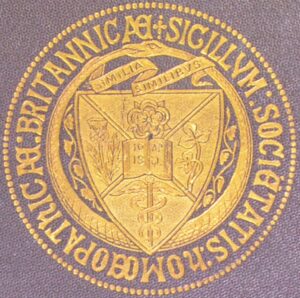
Seal of the British Homeopathic Society
Source: Wellcome Collection
John Pitney Aston L.S.A. (1847 – 15 January 1899) was an orthodox physician who converted to homeopathy and practiced in Eccleshill, Bradford, Yorkshire.
Aston became a member of the British Homeopathic Society and attended the 1895 British Homeopathic Congress, held on Thursday September 19 at the Great Northern Railway Station Hotel in Leeds.
J. P. Aston was appointed as a Medical Officer at the Bath Homeopathic Hospital, where he observed Percy Roberts Wilde. At the hospital Aston also became a colleague of George Newman, George Norman, Edward Christopher Holland, and John Hamilton Mackechnie.
John Pitney Aston was born in St Briavels, Forest of Dean, Gloucestershire, the eldest son of Congregational minister John Aston (1816 – 1903) and Amelia Pitney (1823 – 1908).
Aston determined on a career in medicine and obtained his license from the Worshipful Society of Apothecaries in 1870.
By 1871 Aston was working in Bradford where he was medical assistant to physician and surgeon Christian Henry Taylor L.S.A M.R.C.P. M.R.C. S. (1817 – 1891).
Aston’s career in the interim is unclear but by 1876 he was based in Eccleshill as Medical Officer for the District.
In September 1878, J. P. Aston married Jane Stewart (1853 – 1886) and had a daughter, Amelia Jane Henderson (1879 – 1925). Three years after Jane died, Aston married his wife’s youngest sister, Mary Ann Stewart (1864 – 1937), with whom he had another daughter, Marian Gladys Stewart Aston (1890 – 1969).
By 1881, Aston and his wife Jane were recorded as living at Ellenthorpe House in Eccleshill, Yorkshire. He was later resident at Richmond House in the town, and in the 1890 Medical Register, Aston was listed as residing at 160 Manningham Lane, Bradford.
In January 1893, Aston was elected as a Fellow of the Incorporated Society of Medical Officers of Health.
Mr. J. P. Aston was a physician of the orthodox school with an extensive practice in Yorkshire, where he was Medical Officer of Health for his own district.
Through overwork he had to relinquish his practice for a time, and undertook the lighter labours of medical superin tendent of the West of England ” Hydro.”
While there he became interested in treatment on homoeopathic principles, and made a study of the literature of the subject. In order to have practical opportunities of watching the practice, he attended Dr. Percy Wilde’s clinique at the Homoeopathic Hospital at Bath, and was subsequently elected a member of the honorary staff.
His health having become restored, he returned to the field of his former labours, and made no secret of his belief in the principles of homoeopathy.
This led to antagonism on the part of his former medical colleagues, and a public controversy took place in which Mr. Aston more than held his own. Some news of this controversy appeared in a homoeopathic periodical, but instead of the praise being bestowed on the man who had so boldly supported the cause of homoeopathy against the profession of Yorkshire, Mr. Aston was, perhaps, blamed for not more openly ranking himself amongst the adherents of homoeopathy.
He was too large-minded a man to be hurt by this, but it did not impress him favourably with those responsible for the conduct of the homoeopathic school as a body, and while believing in the truth of the law of similars he always declined to associate himself with the school.
Mr. Aston was always a fearless advocate of every principle he considered right, and was unsparing in the labour he would take to investigate the cause of truth. He was never a blind partisan, but would instantly admit a truth even from an opponent in the heat of controversy. He never stopped to consider on which side his interest lay, he stated what he believed to be true, and was equally ready to give an attentive hearing to his opponent.
In the early days of his study of homoeopathy, he found it necessary to keep a bottle of sacch. ust. in the surgery to provide his remedies with that colour and taste which a Yorkshireman thinks necessary to medicine. One day he prescribed some bryonia for a patient, and took down the sacch. ust. bottle to add the usual complement to his homoeopathic remedy. “Ah,”said the patient,”now I know you will do me good; I always get better when you use that bottle.”
One of Mr. Aston’s contributions to medical literature was “A Protest against the Exclusion of Homoeopathic Works from the Library of the Royal College of Physicians.” This appeared in the Lancet, 1890.
Aston was buried in the Salem Congregational Chapel Chapelyard in Bradford, Yorkshire.
Select Publications:



Leave A Comment